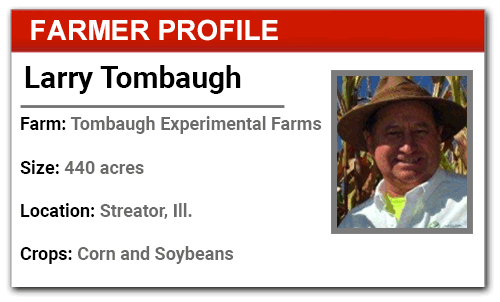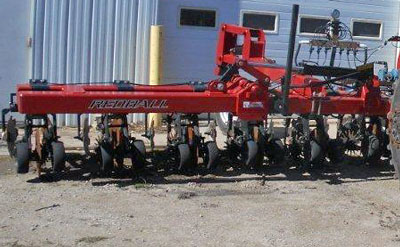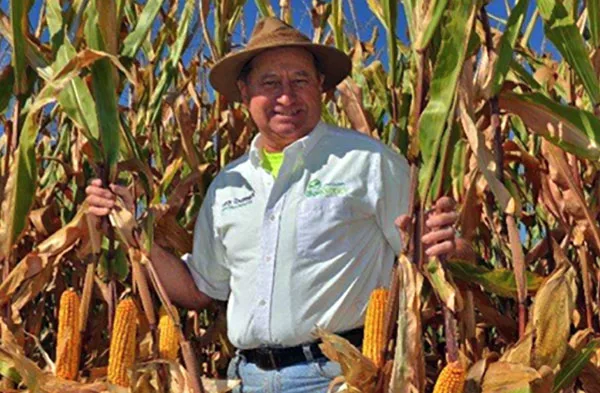Larry Tombaugh says he used to make mistakes farming, but now he calls them “experiments.” That change in attitude has helped him achieve yields near 284 bushel per acre for corn and 80 bushel per acre soybeans on his Streator, Ill., operation.

Tombaugh is a nutrient management specialist and concentrates on precision placement of fertilizer and micronutrients on the 440 acres of ground he farms and an RTK signal is key to making that approach work.
“After applying a residue digester and vertical tillage, we strip-till corn and soybean ground in the fall with no fertilizer,” he says. “We find strip-tilled soil is 9 degrees warmer in the spring than no-tilled soils at planting. The strips yielded 11 bushels per acre more corn over no-till in side-by-side yield tests.”
The RTK signal from his Outback Max guides the Outback STX auto-steering system on Tombaugh’s Case IH 7120 tractor. “RTK makes strip-tillage possible,” Tombaugh says. “We use our system to build naked strips in the fall, then come back in the spring and apply a liquid 28% UAN, Lightning calcium and NMS humic acid with a Redball applicator.”
For planting, he uses his retrofitted 1994 John Deere 7200 planter with Precision Planting’s eSet seed meters that feed seed through a combination cut-down spike and rubber closing wheel assembly. It has Clean Sweep row cleaners and AirForce downforce control.
For starter fertilizer, he applies 3 gallons of Blu Diamond Lightning 3-18-18 with micros, Liquid Force insecticide, root stimulator and NMS Fulvic acid in the row through Totally Tubular units with a Surefire Starter system. He also applies 20 pounds of dry NMS Humate through the insecticide boxes.

Streator, Ill., farmer Larry Tombaugh uses a 12-row Redball strip-till unit to build “naked strips” in the fall and then in spring, modifies the row units with mini mole knives to apply fertilizer.
Yetter 2-inch-by-2-inch applicators mounted to both sides of the row units apply 12 gallons of Blu Diamond 3-18-18 with micronutrients, Lightning Potassium, one half gallon of NMS humate and one gallon of molasses. The planter also features reduced diameter press wheels and Keeton seed firmers with Mojo wires.
For sidedressing, Tombaugh applies 30 gallons of 28% UAN and 1 gallon of NMS humates with a Glencoe field cultivator frame outfitted with spike wheel applicators. “The RTK signal allows us to sidedress fertilizer with the cultivator unit and spike wheels within 8 inches of the row instead of 15 inches away,” Tombaugh says.
What Farmers Want From You is a series of farmer profiles that examine the scope of precision farming tools individual farmers are using on their operation, along with the frustrations that can occur with adopting new technology and how dealers can alleviate those "points of pain" for farm customers. For the latest additions to the series, visit our What Farmers Want From You feed.
Two CDS-John Blue gear-driven pumps feed the fertilizer to a TeeJet flow meter that evenly distributes the sidedressedfertilizer through custom-built manifolds. Tombaugh plans to use his Hagie self-propelled sprayer with a 60 foot boom and Capstan nozzles to foliar apply fertilizer from drop nozzles at the V-2, V-6 and V10 stages. A lightbar in the cab keeps Tombaugh on course and the RTK signal will auto-shutoff boom sections.
Point of Pain: Seeking Better Technical Support
With such an intricate fertility program, Tombaugh needs to have a reliable precision farming technology to execute his plan. But at times, he’s struggled with getting the RTK signal to work with his tractor.
“I tried to install the unit myself and when I finally asked for help, it turns out I had mounted the signal receiver on the wrong side of the tractor. It’s been 3 years since we added the RTK signal, and we are getting the bugs worked out of it. Precision is the key.”
Tombaugh purchased a base station so he’s not paying annual RTK subscription fees. He plans to further fine-tune the system so he can plant double-row corn with 7 inch spacing and 15 inch soybeans with a shifter hitch on his planter.
In the future, Tombaugh hopes to overlay yield maps, soil test maps and soil maps to develop field prescriptions.




![[Technology Corner] Autonomy & Robotics Take Center Stage](https://www.precisionfarmingdealer.com/ext/resources/2026/01/12/Autonomy--Robotics-Take-Center-Stage.webp?height=290&t=1768253759&width=400)


